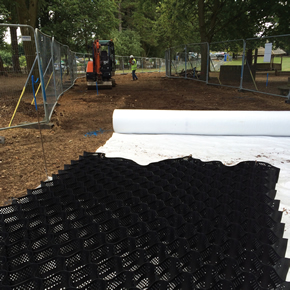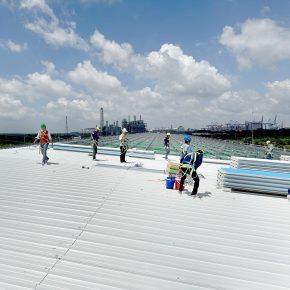
Plotting a path through the trees – constraint or opportunity?
What is the best way to navigate trees on a development? Tom Luck, sustainability consultant at Eight Associates, discusses…
Trees can be assets; they are widely understood to contribute to people’s wellbeing, enhance a development’s desirability and value, reduce noise and the visual impact of traffic; even their shade can help reduce energy costs.
Local and central government have long taken steps to protect the tree stock, but often a development site is acquired and an outline design undertaken, before tree advice has been sought.
Considering trees
The early valuation of tree quality can enable a project design to be flexible enough to incorporate high quality trees – and the ability to integrate trees into close proximity of the project has been shown to increase floor area by more than 10%. However, proposed developments that show the removal of trees that the local authority considers valuable, often falter at planning application stage or require rushed amends to the design at the cost of building design and floor area.
A tree preservation order search should be conducted before acquiring the site. It is an offence to cut down, wilfully damage or destroy a tree protected by that order without the authority’s permission. Owners remain responsible for trees covered by tree preservation orders, with fines of up to £20,000 for damages to protected trees.
The first project design often assumes that the removal of trees is necessary to allow for construction facilitation, such as access, installing utilities or car parks. A tree survey, conducted by an arboricultural consultant, must be submitted where there are trees within, or adjacent to, a proposed planning application site, which could be affected by the development.
A tree survey is required to inform the impact assessment, which is used by the local authority to draw conclusions about planning permission. Arboricultural advice at this stage could enhance the design by showing how light construction techniques are possible within the Root Protection Area (RPA) of trees.
Protecting trees on site
Trees have three fundamental requirements – light, water and aerated soil. Tree roots are generally found in the top 800mm of soil and extend via the path of least resistance radially from the stem.
The BS 5837:2012 Trees in Relation to Design, Demolition and Construction – Recommendations, provides a calculation for establishing the area around a tree in which roots are likely to be found. The RPA can be calculated by multiplying the stem diameter by 12, at 150mm from ground level, to provide a radius from the stem.
Two regular causes of damage to trees include soil compaction and root severance. Soil compaction can be caused by vehicular or pedestrian traffic through the RPA, squeezing the oxygen held in the pores of the soil. Root severance occurs during excavation works within the RPA.
There are technical solutions to construction within the RPA of existing trees: One option is Cellular Confinement Systems (CCS). CCS is a versatile hard plastic mesh, which can be overlaid on soils to spread the load laterally and drastically reduce soil compaction created by pedestrian and vehicular traffic. This is a nodig solution, as the CCS mesh is laid over the existing soil and filled with a clean, granular sub-base to allow for soil aeration.
This is levelled and compacted, topped with a further layer of geotextile and a sub-base, and a permeable surface added, such as porous asphalt, porous block paving, and gravels. This system is appropriate for driveways and car parking solutions in and around existing trees on site.
Traditional strip footings can result in substantial root loss. Using the smallest practical pile diameter when installing piling near trees reduces the possibility of striking substantial tree roots – and reduces the size of the rig required to sink the piles. In some cases, it is possible to insert specially engineered structures within the RPAs.
The viability is assessed through an exploratory investigation involving the careful excavation within the RPA to create a number of concrete columns to support a cantilevered slab.
A ventilated air space between the underside of the slab and the existing soil is needed to enable gaseous exchange through the soil and a specialist irrigation system is required. These and CCS solutions must adhere to BS 5837:2012, advice from a suitable engineer, specialist arboriculturalist and the local authorities’ requirements.
Is it worth the effort?
Yes, in nearly every case. For example, if boundary trees that have been identified as good quality and a prominent landscape feature are on site it is possible, with some relatively minor rearrangements, to extend into the RPAs for the driveway and parking.
The consideration of trees on development sites is often seen as a hurdle. Working with an arboricultural consultant as early as possible in the project means the expert consideration of existing trees on site could lead to a smoother journey through the planning process, and a viable design with a maximised footprint.
Latest news

16th April 2024
Mitsubishi Electric set to host CIBSE Journal webinar
Mitsubishi Electric will host a CIBSE Journal webinar on Wednesday 24th April 2024 at 1pm to discuss the legislation and initiatives driving changes in the way we will need to heat, cool and ventilate large commercial buildings to reach net zero emissions in the UK.
Posted in Air Conditioning, Articles, Building Industry Events, Building Industry News, Building Products & Structures, Building Regulations & Accreditations, Building Services, Facility Management & Building Services, Heating Systems, Controls and Management, Heating, Ventilation and Air Conditioning - HVAC, Information Technology, Pipes & Fittings, Plumbing, Seminars, Sustainability & Energy Efficiency, Training
16th April 2024
Hamworthy: What to consider when choosing a heat pump?
At the heart of an efficient heat pump system lies an important element: the refrigerant – Jason Allen, Commercial Product Manager, Groupe Atlantic UK, ROI & NA. Hamworthy Heating is a Groupe Atlantic brand.
Posted in Articles, Building Industry News, Building Products & Structures, Building Services, Facility Management & Building Services, Heating Systems, Controls and Management, Heating, Ventilation and Air Conditioning - HVAC, Pipes & Fittings, Plumbing, Retrofit & Renovation, Sustainability & Energy Efficiency
15th April 2024
EJOT Colorfast chosen for Kingspan’s highly sustainable new Asian factory
More than 120,000 EJOT Colorfast self-drilling fasteners have helped Kingspan to create a thermally superior, visually-appealing building envelope for its first purpose-built manufacturing plant in South East Asia.
Posted in Articles, Building Industry News, Building Products & Structures, Building Systems, Case Studies, Posts, Restoration & Refurbishment, Retrofit & Renovation, Roofs, Sustainability & Energy Efficiency
15th April 2024
ASSA ABLOY helps new manufacturing plant achieve LEED Gold certification
Improving sustainability performance is becoming a higher priority for building developers, owners and users. One consequence is fast-growing demand for green building certifications — and therefore specification. Specialist input can make the difference between hitting and missing a project target, as ASSA ABLOY explains here…
Posted in Access Control & Door Entry Systems, Architectural Ironmongery, Articles, BIM, Infrastructure & CAD Software, Building Industry News, Building Products & Structures, Building Regulations & Accreditations, Building Services, Case Studies, Doors, Facility Management & Building Services, Information Technology, Retrofit & Renovation, Security and Fire Protection, Sustainability & Energy Efficiency
 Sign up:
Sign up: 